Using Japanese on a Mac
This site describes how to use Japanese on a Macintosh computer, particularly for people who use a Mac predominantly in English but also want to read, write, browse, and email in Japanese. This front page contains information on activating Japanese support in macOS: start by following the instructions below, then consult the other pages on the site for information on specific tasks and applications: text processing, web browsing, dictionary software, etc.
The instructions on this site are up to date for macOS 12 (Monterey), but you can use them with very slight changes for any fairly recent version of macOS.
Getting Started: How to Enable Japanese Input in macOS
If you just want to read Japanese on your Mac--receive Japanese email or go to a Japanese web page--the Japanese will display correctly without your doing anything special or reading any further on this page. If this does not work smoothly, if you want to enable additional features, or if you want to input Japanese text (to create documents, do web searches, or send email in Japanese), you'll need to take a couple of extra steps.
To enable input in Japanese (or other Asian languages), go to System Preferences from the Apple menu, click on the preferences pane labeled Keyboard, and select the Input Sources tab. Click on the button marked with a plus sign in the lower left, then select Japanese from the menu. Finally select "Japanese - Romaji" from the list at right and click "Add."
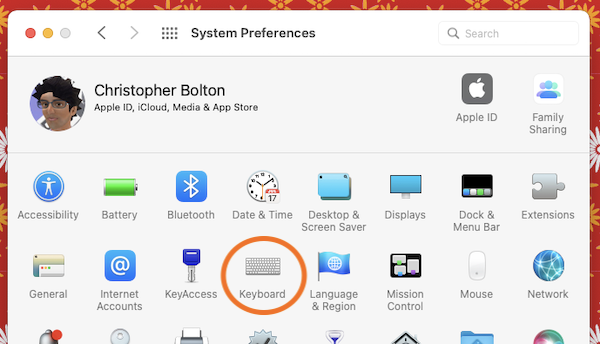
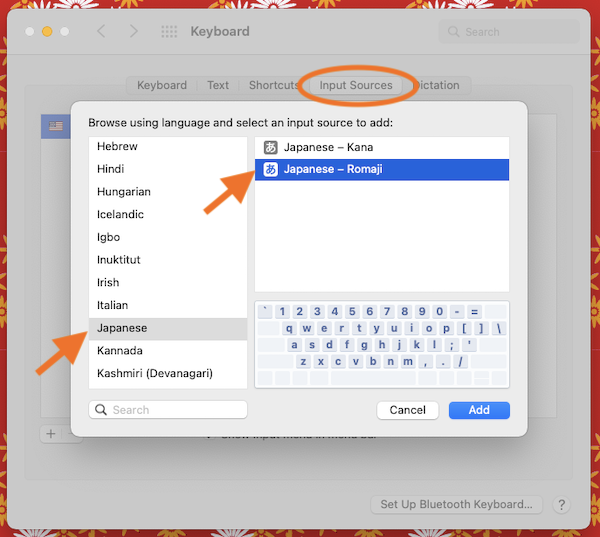
Now when you highlight Japanese - Romaji in the list at left, you'll see the different Japanese input preference options. I recommend you set them as follows to start out:
- Check the boxes for hiragana and katakana.
- Uncheck the "Live Conversion" box for now.
- Scroll down a little further in the panel (past the content shown below) and find an option called "Predictive Candidates" it should be unchecked.
- Check the box that says "Show input menu in menu bar" at the bottom of the preferences pane.

If you have a trackpad, you may also want to click on the "+" box one more time, select "Traditional Chinese" or "Simplified Chinese," and choose the "Handwriting" input method. This will let you enter Japanese kanji characters by drawing them on the trackpad, as described elsewhere on this site.

If you now look at the menu bar at the very top of the screen, you should see the icon for the input menu--it probably looks like a little flag. You can now select Hiragana or Katakana from that menu to enter Japanese text in almost any application. For more on how to enter Japanese text, see the page on Typing in Japanese elsewhere on this site.) If Hiragana or Katakana is already selected as the input method when you click on the input menu, you'll get a longer menu with options specific to Japanese input, including a help option.
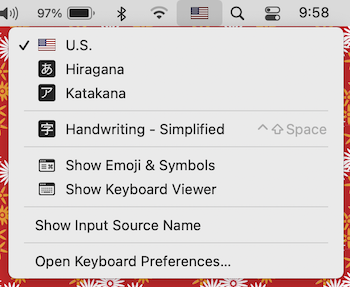
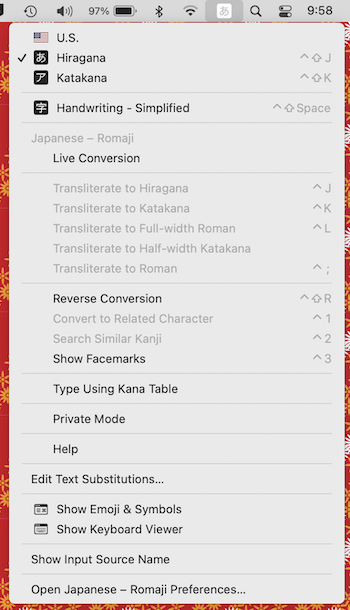
Do I need a Japanese Keyboard?
The short answer is no: the vast majority of users (including native speakers) enter Japanese by typing the pronunciation in roman characters, so you do not need a special Japanese keyboard. If you have a Japanese a keyboard, it will have a slightly different key layout as well as the option of dispensing with roman character input and having each key map to a specific kana character (when you choose the kana input method in the Japanese input preferences). You can get a Japanese keyboard as an option when you purchase a desktop on Apple's US web site, but it's not necessary for most users.
Next Steps
For a guide to entering text in Japanese, see the page on Typing in Japanese, elsewhere on this site. For an introduction to using Japanese with different applications, see other links in the navigation bar at left.
Optional: Choosing English or Japanese Menus in Applications
If you would like the finder or other applications to display with Japanese menus, go to System Preferences under the Apple menu, then select the Language & Region preferences pane.
Click on the "Apps" tab, and use the "+" button near the bottom to add an application to the list: a pop-up menu lets you select Japanese for the application's default language (if the developers have included Japanese support). This will cause the app's menus to display in Japanese, and may affect some other options in the app as well.
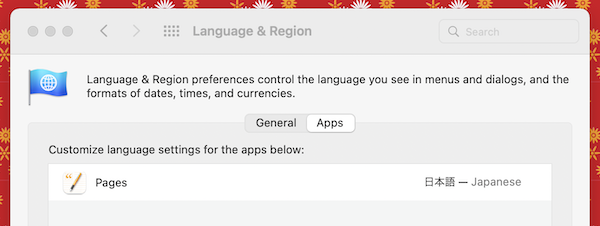
If you want to change the default language for all applications (including the Finder), you can go back to the "General" tab in the same Language & Region pane of the System Preferences, and click on the "+" box to add Japanese to the list of system languages. Then you can drag Japanese above English in the list, and it will become the preferred system language: the finder and many other applications will open next time with Japanese menus. (Be careful with this: if you can't read Japanese well, you may have trouble navigating your new Japanese Finder well enough set it back easily.)